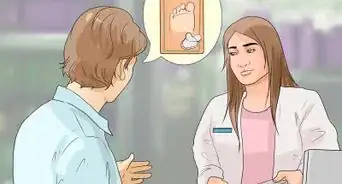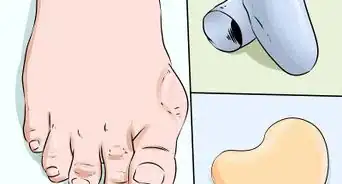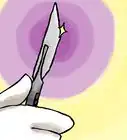This article was co-authored by Miguel Cunha, DPM. Dr. Miguel Cunha is the founder of Gotham Footcare and is a podiatrist based in Manhattan, New York. Dr. Cunha is a foot and ankle surgeon with experience treating a wide array of foot and ankle conditions from minor problems to complex reconstructive foot and ankle surgery. Dr. Cunha received his DPM from the Temple University School of Podiatric Medicine and completed his residency as the Chief Resident at the Washington Hospital Center and Georgetown University where he specialized in lower extremity trauma, diabetic limb salvage, and reconstructive surgery of the foot and ankle. Dr. Cunha is a member of the American Podiatric Medical Association, the New York Podiatric Medical Association, the American College of Foot and Ankle Surgeons, and is board certified in Podiatric Medicine.
There are 7 references cited in this article, which can be found at the bottom of the page.
wikiHow marks an article as reader-approved once it receives enough positive feedback. In this case, several readers have written to tell us that this article was helpful to them, earning it our reader-approved status.
This article has been viewed 443,973 times.
Corns, also called helomas, are thickened skin that usually forms on the feet. They're usually due to friction on your foot.[1] The thickening is a natural way for the skin to protect itself, usually in the form of a conical, waxy protrusion on the feet, and occurs because of excessive pressure. Foot abnormalities, protuberant bones, ill-fitting footwear, and gait irregularities can lead to these oftentimes painful formations.[2] The good news is, proper use of corn caps (i.e. corn plasters) provide a simple, safe, and effective means of removing the growths.
Steps
Correctly Applying the Corn Cap
-
1Clean and dry the area surrounding the corn. Thoroughly washing and drying the area helps to ensure firm adhesion. Without a solid connection there is a chance the corn cap strip will slip out of place and lose effectiveness, or potentially come in contact with healthy skin.
-
2Remove the corn cap from the backing. Just like a Band-aid, the adhesive section is pressed against a rubber backing that ensures nothing sticks to it before being applied. Discard the backing once it has been fully separated from the adhesive portion.Advertisement
-
3Place the circle directly over the corn. Press it down firmly, adhesive side facing the skin.[3] The cap contains silicone gel that will protect the corn, eliminating the friction that caused the corn in the first place.[4]
- If you're using a medicated cap, the gel needs to penetrate the skin directly on the corn, and if possible, the edges as well, as there may be portions of the corn that have grown laterally along the skin.
- Use separate adhesive strips on the edges to keep the corn cap in place.
- If using the corn cap on a toe, wrap the adhesive portion all the way around the toe.
Expert Warning: Using medicated corn remover can create an ulcer or burn your skin, so it's best to use cushioned gel caps to relieve pressure and friction on the corn.
-
4Reapply corn caps as necessary. In general, the corn caps should be reapplied every two days. It is possible, however, for some corn plasters to be reapplied daily until the corn is removed, or for a maximum of two weeks, whichever comes first.[5]
- Apply the corn cap precisely as the instructions direct. Unnecessarily high absorption through the skin may occur if overused or improperly used.[6]
-
5Monitor for allergic reactions. Allergic reactions may include, but are not limited to skin redness, itchiness, or a rash. Soreness and discomfort, both mild and severe, are common. If the irritation persists or becomes severe, you may be experiencing some form of salicylic acid toxicity.[7]
- Severe reactions are rare, but anaphylaxis has been reported with use of salicylic acid.[8]
-
6Consult with a physician if corn caps are ineffective. You should consult with a general physician, podiatrist, or dermatologist if your corn is painful, recurrent and not responding to corn paint. They might order an X-ray of your feet to rule out underlying bony abnormality and refer to an orthopedics if needed.[9]
- To prevent corns, wear wide-fitting shoes that give your toes plenty of wiggle room.[10]
- If you have a condition like hammer toes that cause your feet to rub against the inside of your shoe, you're more likely to have corns develop. If you need to, wear an orthotic or custom orthotic inside your shoe to evenly distribute your weight across your feet, which can help prevent hammertoe from forming in the first place.[11]
Storing the Corn Caps
-
1Keep out of reach of children. While the product is fairly benign when used properly, the salicylic can be dangerous in the hands of a child. Application to facial skin could result in a chemical burn, and ingestion could cause nausea, vomiting, and even problems with the ear.
-
2Store at temperatures below 30˚C/86˚F. Storage above these temperatures will likely cause the product to lose some effectiveness. The adhesive on the ring will probably slip, and the salicylic acid will not be concentrated directly over the corn.[12]
- Also ensure the product is stored away from direct sunlight or severe humidity.
-
3Refrain from using the product after the expiration date. Similar to heat-based degradation, age-based degradation will limit product efficacy. Aside from the adhesive inadequacy, the foam ring often included for comfort may lose its soft, spongy texture that protects against rubbing and helps alleviate some of the pain associated with corns.[13]
Expert Q&A
-
QuestionHow do you get rid of corns on your feet?
 Miguel Cunha, DPMDr. Miguel Cunha is the founder of Gotham Footcare and is a podiatrist based in Manhattan, New York. Dr. Cunha is a foot and ankle surgeon with experience treating a wide array of foot and ankle conditions from minor problems to complex reconstructive foot and ankle surgery. Dr. Cunha received his DPM from the Temple University School of Podiatric Medicine and completed his residency as the Chief Resident at the Washington Hospital Center and Georgetown University where he specialized in lower extremity trauma, diabetic limb salvage, and reconstructive surgery of the foot and ankle. Dr. Cunha is a member of the American Podiatric Medical Association, the New York Podiatric Medical Association, the American College of Foot and Ankle Surgeons, and is board certified in Podiatric Medicine.
Miguel Cunha, DPMDr. Miguel Cunha is the founder of Gotham Footcare and is a podiatrist based in Manhattan, New York. Dr. Cunha is a foot and ankle surgeon with experience treating a wide array of foot and ankle conditions from minor problems to complex reconstructive foot and ankle surgery. Dr. Cunha received his DPM from the Temple University School of Podiatric Medicine and completed his residency as the Chief Resident at the Washington Hospital Center and Georgetown University where he specialized in lower extremity trauma, diabetic limb salvage, and reconstructive surgery of the foot and ankle. Dr. Cunha is a member of the American Podiatric Medical Association, the New York Podiatric Medical Association, the American College of Foot and Ankle Surgeons, and is board certified in Podiatric Medicine.
Board Certified Podiatrist
-
QuestionNow after I've applied four corn caps, each for two days, the corn is soft and there is something white in it. Should I remove the white thing or just leave it?
 Chris M. Matsko, MDDr. Chris M. Matsko is a retired physician based in Pittsburgh, Pennsylvania. With over 25 years of medical research experience, Dr. Matsko was awarded the Pittsburgh Cornell University Leadership Award for Excellence. He holds a BS in Nutritional Science from Cornell University and an MD from the Temple University School of Medicine in 2007. Dr. Matsko earned a Research Writing Certification from the American Medical Writers Association (AMWA) in 2016 and a Medical Writing & Editing Certification from the University of Chicago in 2017.
Chris M. Matsko, MDDr. Chris M. Matsko is a retired physician based in Pittsburgh, Pennsylvania. With over 25 years of medical research experience, Dr. Matsko was awarded the Pittsburgh Cornell University Leadership Award for Excellence. He holds a BS in Nutritional Science from Cornell University and an MD from the Temple University School of Medicine in 2007. Dr. Matsko earned a Research Writing Certification from the American Medical Writers Association (AMWA) in 2016 and a Medical Writing & Editing Certification from the University of Chicago in 2017.
Family Medicine Physician I recommend that you clean the corn throughly. Then I would reapply a new corn wrap.
I recommend that you clean the corn throughly. Then I would reapply a new corn wrap. -
QuestionCan I use a corn cap on a hand corn?
 Chris M. Matsko, MDDr. Chris M. Matsko is a retired physician based in Pittsburgh, Pennsylvania. With over 25 years of medical research experience, Dr. Matsko was awarded the Pittsburgh Cornell University Leadership Award for Excellence. He holds a BS in Nutritional Science from Cornell University and an MD from the Temple University School of Medicine in 2007. Dr. Matsko earned a Research Writing Certification from the American Medical Writers Association (AMWA) in 2016 and a Medical Writing & Editing Certification from the University of Chicago in 2017.
Chris M. Matsko, MDDr. Chris M. Matsko is a retired physician based in Pittsburgh, Pennsylvania. With over 25 years of medical research experience, Dr. Matsko was awarded the Pittsburgh Cornell University Leadership Award for Excellence. He holds a BS in Nutritional Science from Cornell University and an MD from the Temple University School of Medicine in 2007. Dr. Matsko earned a Research Writing Certification from the American Medical Writers Association (AMWA) in 2016 and a Medical Writing & Editing Certification from the University of Chicago in 2017.
Family Medicine Physician Yes, I believe that you can use it on your hand. Just be make sure to secure the corn cap so that it does not fall off.
Yes, I believe that you can use it on your hand. Just be make sure to secure the corn cap so that it does not fall off.
Warnings
- People with severe circulatory disorders should seek medical advice.⧼thumbs_response⧽
- This is only for external use.⧼thumbs_response⧽
- Do not use if skin is broken.⧼thumbs_response⧽
- Corn caps should not be used by diabetics.⧼thumbs_response⧽
References
- ↑ Miguel Cunha, DPM. Board Certified Podiatrist. Expert Interview. 22 April 2020.
- ↑ http://www.medicinenet.com/corns/page3.htm
- ↑ https://www.youtube.com/watch?v=w_r5TiOJ0YY
- ↑ Miguel Cunha, DPM. Board Certified Podiatrist. Expert Interview. 22 April 2020.
- ↑ https://www.youtube.com/watch?v=w_r5TiOJ0YY
- ↑ http://www.dermnetnz.org/treatments/salicylic-acid.html
- ↑ http://emedicine.medscape.com/article/1009987-overview
- ↑ http://www.dermnetnz.org/treatments/salicylic-acid.html
- ↑ http://www.dermatocare.com/blog/Foot-corns--how-to-get-rid-of-corn-know-from-a-dermatologist
- ↑ Miguel Cunha, DPM. Board Certified Podiatrist. Expert Interview. 22 April 2020.
- ↑ Miguel Cunha, DPM. Board Certified Podiatrist. Expert Interview. 22 April 2020.
- ↑ https://www.youtube.com/watch?v=w_r5TiOJ0YY
- ↑ https://www.youtube.com/watch?v=w_r5TiOJ0YY
About This Article
To use corn caps, start by washing and drying the area surrounding the corn. Then, peel the backing off of the corn cap like you would with a Band-Aid, and firmly press the circle on the cap onto the corn. Reapply the corn cap every 2 days or per the manufacturer's instructions. If you notice any skin redness, itchiness, pain, or a rash, stop using the corn caps and consult with a physician. To learn how to store corn caps, scroll down!







































































Medical Disclaimer
The content of this article is not intended to be a substitute for professional medical advice, examination, diagnosis, or treatment. You should always contact your doctor or other qualified healthcare professional before starting, changing, or stopping any kind of health treatment.
Read More...